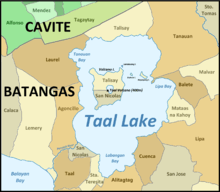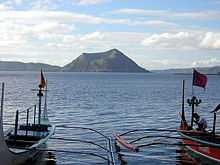Taal Lake
| Taal Lake | |
|---|---|
 Satellite image showing Taal Lake with Volcano island within it | |
| Location | Batangas |
| Coordinates | 13°59′13″N 121°00′44″E / 13.98694°N 121.01222°ECoordinates: 13°59′13″N 121°00′44″E / 13.98694°N 121.01222°E |
| Type | Caldera lake |
| Primary outflows | Pansipit River |
| Basin countries | Philippines |
| Max. length | 25 km (16 mi) |
| Max. width | 18 km (11 mi) |
| Surface area | 234.2 km2 (90.4 sq mi) |
| Average depth | 100 m (330 ft)[1] |
| Max. depth | 172 m (564 ft)[1] |
| Shore length1 | 115 km (71 mi) |
| Surface elevation | 5 m (16 ft) |
| Islands | Bubuin, Lambauing, Napayon and Volcano Islands |
| Settlements | Talisay, San Nicolas, Lipa City, Laurel, Tanauan City, Santa Teresita, Mataas na Kahoy, Balete, Cuenca, Alitagtag, and Agoncillo |
| 1 Shore length is not a well-defined measure. | |
Taal Lake is a freshwater lake in the province of Batangas, on the island of Luzon in the Philippines. The lake fills Taal Caldera, a large volcanic caldera formed by very large eruptions between 500,000 and 100,000 years ago. It is the country's third largest lake after Laguna de Bay and Lake Lanao. Volcano Island, the location of Taal Volcano's historical eruptions and responsible for the lake's sulfuric content, lies near the center of the lake. There is a crater lake on Volcano Island, which is the world's largest lake on an island (Volcano Island) in a lake (Taal Lake) on an island (Luzon). Known as the Yellow Lake or the Main Crater Lake,[2] it contains its own small island, Vulcan Point.
Protected area and management
The Taal Lake basin was first declared as a national park, the Taal Volcano National Park, by Proclamation no. 235 on July 22, 1967 covering 62,292 hectares (153,930 acres).[3]
Under Republic Act 7586, otherwise known as the National Integrated Protected Areas System (NIPAS) Act of 1992, the area was reestablished as the Taal Volcano Protected Landscape by Proc. 906 on October 16, 1996.[4] The protected area is managed by a Protected Area Management Board (PAMB) and has a Chief Operating Officer called a Protected Area Superintendent. A Management Plan was crafted and approved by the PAMB in 2009 and now serves as the blueprint for lake conservation.
History

Taal Lake was once just an arm of Balayan Bay. A series of major eruptions in the early 18th century battered the lakeside towns with earthquakes and volcanic debris.[5] The activity culminated in 1754 with Taal Volcano's largest eruption that blocked Pansipit River with tephra, eventually submerging some of the towns by the rising lake waters, as the lake's sole outlet to the sea was blocked. (Remnants of the old lakeside towns are reported can be seen under the lake's waters).[6][7] The poblaciones (town centers) of Lipa, Taal, Sala, Bauan and Tanauan, formerly located along Taal Lake, were moved away and reestablished several kilometers away from its shore after the activity had subsided.
Since the 1754 eruption, the surface elevation had gone up from sea level (as the lake was freely navigable from Balayan Bay) to 5 metres (16 ft) above sea level. Several centuries of precipitation have diluted the lake's once saline waters into freshwater.
Over a century after the big eruption, newer towns along the lake were again established, carved from the larger towns - Talisay (established 1869, from Taal), Cuenca (1877, from San Jose), Alitagtag (1910, from Bauan),[8] Mataasnakahoy (1932, from Lipa), Agoncillo (1949, from Lemery), San Nicolas (1955, at the former location of Taal town), Laurel (1961, from Talisay), Santa Teresita (1961, from Taal, San Luis and San Nicolas) and Balete (1969, from Lipa).[9]
Ecology
Because the lake was previously connected to the sea, it is home to many endemic species that have evolved and adapted to the desalination of the lake's waters. The lake has a freshwater-adapted population of trevally, Caranx ignobilis. This fish, also found in Pansipit River, is locally called maliputo. Its most popular endemic species is the overharvested Sardinella tawilis, a freshwater sardine. The two other endemic fish species in Taal Lake are the gobies Gnatholepis volcanus and Rhinogobius flavoventris.[10][11]
Taal Lake is also home to one of the world's rarest sea snakes, Hydrophis semperi. This particular species is only one of two "true" sea snake species that are known to live entirely in freshwater(the other is Laticauda crockeri from the Solomon Islands). Bull sharks, Carcharhinus leucas, used to be part of the lake's once-diverse ecosystem but were extirpated by the locals by the 1930s.
Introduction of a non-native fish
Jaguar guapote (Parachromis managuensis), a predatory piscivore, a carnivorous fish that primarily eats other fishes, was found illegally introduced into the lake. The alien fish could proliferate in all areas of lake because of the abundant aquatic vegetation which they use for spawning and feeding, plenty of natural food, and favorable warm environment. Its presence could seriously affect the native fish population.[12]
Fish kill

On January 5, 2008, the Bureau of Fisheries and Aquatic Resources announced that a fish kill at Taal Lake (January 2 to 4) caused the 50 metric tons or ₱ 3.25-million ($79,268) loss of cultured tilapia in the villages of Leviste and Balakilong in Laurel and in Barangay Aya and Barangay Quiling in Talisay. 6,000 maliputo fishes ($5,609) also died at Quiling. Toxic sulfur and high level of hydrogen sulfide in Ambulong while low dissolved oxygen caused the deaths.[13]
On May 30, 2011, the Bureau of Fisheries and Aquatic Resources announced a fish kill of 750 metric tons. According to the scientists, the onset of the rainy season brought a sudden drop on the water temperature, which lowered the oxygen levels on the lake.[14]
Tourism
Regular tours of the lake are available to tourists. After crossing the lake, visitors travel to the top of Volcano Island on horseback. During their trip up and down the mountain, visitors are treated to a stunning view of the lake and its surroundings.
In mid-2007, controversy ensued when the Korean firm Jung Ang Interventure was given clearance to build a health spa on Volcano Island itself along the lake's edge. Over the course of the next few weeks, several government officials expressed their disapproval of the construction project.[15][16]
On June 28, the DENR suspended the Korean firm's environmental clearance certificate, rendering them incapable of pursuing further construction on the island until they secure other necessary permits.[17] Because of the unpopular public reaction to the project, the Korean company's permit was permanently revoked by the DENR in early July 2007.[18]
Gallery
-

A view of the lake from an elevated terrain.
-
A view of the lake during a cloudy day.
-

View of the Taal Volcano from the lake with local fishing boats on the foreground.
| Wikimedia Commons has media related to Taal Lake. |
See also
References
- ↑ 1.0 1.1 "Lake Taal". International Lake Environment Committee. Retrieved on 2012-03-17.
- ↑ U.S. Army Corps of Engineer (1954). "Manila (Topographic map)". University of Texas in Austin Library. Retrieved on 2014-08-03.
- ↑ "List of initial components of Nipas Act". Protection and Wildlife Bureau. Retrieved on 2012-01-13.
- ↑ "Protected Areas in Region 4-A (CALABARZON)". Protection and Wildlife Bureau. Retrieved on 2012-01-13.
- ↑ (2003). "Taal flyer - Chronology of Historical Eruptions of Taal Volcano". PHIVOLCS. Retrieved on 2014-08-03.
- ↑ Hargrove, Thomas (1991). "The Mysteries of Taal, a Philippine volcano and lake, her sea life and lost towns". Bookmark, Manila. ISBN 971-569-046-7.
- ↑ betaxfer1 (2012-12-08). "The Mysteries of Taal Pt.1 - Thomas Hargrove from Pep Talk w. Loren Legarda". YouTube. Retrieved on 2014-08-03.
- ↑ "Alitagtag, Batangas History". Wow Batangas. Retrieved on 2014-08-03.
- ↑ "History". Talisay, Batangas Official Website. Retrieved on 2014-08-03.
- ↑ Froese, Rainer and Pauly, Daniel, eds. (2012). "Gnatholepis volcanus" in FishBase. November 2012 version.
- ↑ Froese, Rainer and Pauly, Daniel, eds. (2012). "Rhinogobius flavoventris" in FishBase. November 2012 version.
- ↑ (2006). "Biological Investigation of Jaguar Guapote Parachromis managuensis (Gunther) in Taal Lake, Philippines". Journal of Environmental Science and Management, Vol 9, No 2.
- ↑ Luistro, Marlon Alexander (2008-01-05).Inquirer.net, "Taal Lake fishkill causes ₱3-M losses". Philippine Daily Inquirer. Retrieved on 2011-01-15.
- ↑ Celis, Noel (2011-05-30). "Philippines struggles under mountain of dead fish". AFP. Retrieved 2011-05-30.
- ↑ Ramos, Marlon (2007-06-25). "Batangas, Tagaytay execs oppose Taal spa project". Breaking News: Regions (Inquirer.net). Retrieved 2007-07-08.
- ↑ Torres, Tetch (2007-06-27). "Vilma Santos takes oath, says vs Taal spa". Eleksyon 2007 Special Coverage (Inquirer.net). Retrieved 2007-07-08.
- ↑ Contreras, Volt (2007-06-30). "DENR gives Taal spa firm 1-week ultimatum". Headlines: Nation (Inquirer.net). Retrieved 2007-07-08.
- ↑ Andraneda, Katherine (2007-07-06). "DENR cancels Taal spa permit". Philippine Headline News Online. Retrieved on 2011-01-15.
External links
- Mysteries of Taal. Author Thomas Hargrove talks about the 1754 eruption that changed Taal Lake.
- Taal Lake at Global Nature Fund.
- Taal Lake at the Society for the Conservation of Philippine Wetlands, Inc.
- Trek to Taal Volcano. Guide to Taal Lake from Philippine Journeys.
- Some interesting Islands and Lakes
- International Lake Environment Committee: Lake Taal
Dr Brian Cox "The Wonders of Life" BBC Series1 episode1. 2013. Discussion on L. Taal with footage.
| ||||||||||||||
